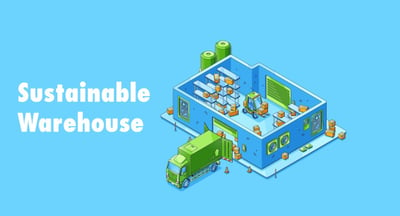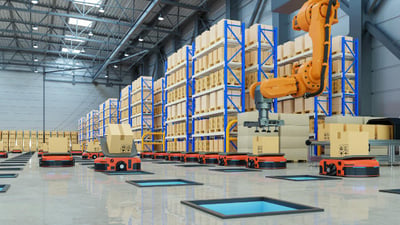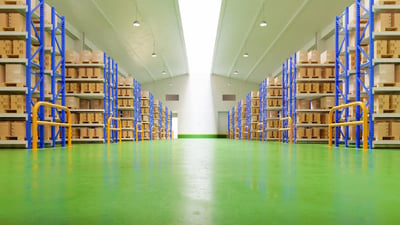
Prioritizing sustainability is at the forefront of many business owners' minds now that environmental issues are finally taking center stage. Given the enormity of energy consumption in the commercial and industrial sector, it’s no wonder that companies in this space are under heightened pressure and scrutiny to go green. When it comes to supply chain logistics, many improvements can be made to reduce waste and optimize the eco-friendly nature of operations.
As a manufacturer, you can do your part by connecting with warehouses or building a warehouse that prioritizes sustainable methods of operation. Here's a list of things to do to optimize your warehouse, from easy options to more expensive but extremely efficient methods.
LED lighting and prioritizing energy efficiency

Given the size of the warehousing industry, the first clue that a warehouse prioritizes sustainability is the presence of exclusively LED lighting. LED lighting not only lasts up to 25 times longer than regular incandescent bulbs, but uses as much as 75% less energy, too.
An estimated 91% of energy consumption from indoor illumination in commercial and industrial premises is from lighting fixtures. So, switching to LED alternatives can translate to big energy-efficient savings.
Additionally, when companies make the switch to LED lighting, they can also opt for lighting controls that allow for further savings. For example, lighting controls can be programmed to work on settings such as occupancy detection and daylight-sensing to eradicate any wasteful energy consumption of unused lighting.
Without taking vital measures to improve sustainability measures, warehouse operations typically consume vast amounts of energy. By adopting automated solutions, which we’ll talk through in more detail later, you can potentially operate without light or temperature control, thus saving a great deal of energy. This can also dramatically reduce operating costs, which can see warehouse companies recouping the initial outlay for such high-tech solutions quickly.
Automation

Incorporating automation solutions in warehousing processes can go a long way towards creating a more sustainable system of operation, and there are many options available that aren’t hugely expensive to install.
Automated warehouse systems allow for far more accuracy in product management, recall, etc. This results in significant savings in the time, energy and resources typically required to fulfill these management tasks. A prime example is the reduction in paper consumption that is achievable when companies switch to digital solutions such as RFID (radio-frequency identification) and bar-coding technologies.
Other automated solutions include:
- Order picking technologies
- Cloud-based access control systems to secure warehouses
- Automated storage and retrieval systems (ASRS)
In many cases, implementing an ASRS can avoid the enormous environmental impact that building a new premise can cause, as these systems allow for optimized use of vertical space, thus maximizing the efficient use of a company's current warehouse space as they grow.
Warehouse management systems (WMS)

Regardless of the industry it serves, the efficiency of warehouse operations is integral to the overall success of a supply chain. In many cases, improving efficiency equals improved sustainability because it helps ensure quick, accurate shipments.
Warehouse management systems are increasingly being adopted to optimize efficiency within the logistics network. A warehouse management system is essentially software that controls and streamlines warehouse operations from goods entering to leaving the warehouse.
Warehouse management software has many other benefits, including:
- Live inventory management for optimal control over products and materials
- Real-time planning and management of scheduling, production, and resources
- Omnichannel order management of B2B and e-commerce sales
- End-to-end traceability for accuracy in tracing specific materials, batches, and more
Warehouse management systems not only optimize operational efficiency but also offer a variety of opportunities to reduce the warehouse's environmental footprint, especially when combined with automation technologies.
Optimal warehouse design

If the warehouse of your choice has yet to implement some of the more sophisticated systems such as ASRS, at least consider whether it is positioned to be able to in the near future. As well as directly discussing the warehouse's plans to move towards improved sustainability, consider the design of the space and whether it will allow for such improvements.
Careful warehouse layout planning is vital for maximizing operational efficiency, but also helps to ensure that the integration of new systems and functions is viable. Vendor Tech recommends doing this through the following method:
- Assigning a unique name for each location in your warehouse (Latin alphabet). Find out more on that here.
- When you have names of all the locations, you can generate labels with barcodes.
- Print the labels and paste at all of your warehouse locations.
- Next, teach your WMS to calculate optimal routes for pickers (which can be done easily through most inventory management software systems). It’s worth doing this manually too to ensure it is the optimal, time-saving route.
- Finally, import the locations with assigned priority to your WMS.
Complete optimization of warehouse space is crucial to the optimization of efficient material and equipment handling, as well as the ability to integrate technologies such as Automated Guided Vehicles (AGV). It's essential to choose a warehouse with the capabilities and foresight to adopt new sustainability solutions as they grow.
Final thoughts
Warehouses play a significant role in driving the global economy towards ever-improving smart and sustainable systems. As a manufacturer, you can essentially 'vote with your feet' and play your own part in the push for environmentally-friendly industrial operations by selecting a warehouse that focuses on sustainability in its design and processes. Request information on their recycling and disposal practices too, as well as how diligently they source green-manufactured products.
In addition, the benefits of sustainability in warehouse practices reach further than the environment. A warehouse that is comfortably and appropriately heated, lit, and organized will attract and retain the best workers, leading to further improvement in productivity.







